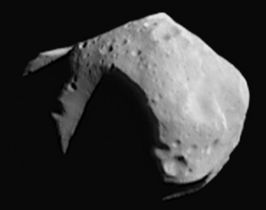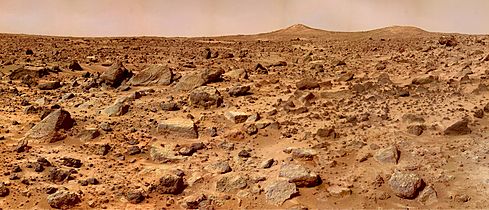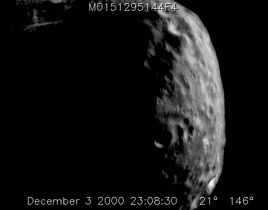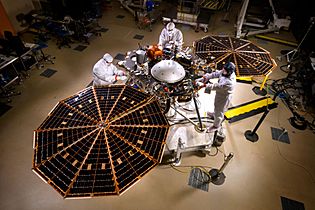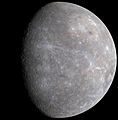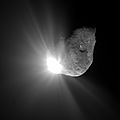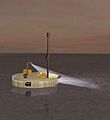Discovery Program facts for kids
The Discovery Program is a cool series of space missions funded by NASA, the U.S. space agency. These missions explore our Solar System. What makes them special is that they cost less than some of NASA's bigger missions. This means each Discovery mission usually focuses on one main science goal, making them super focused!
The program started in 1990. NASA wanted to launch space missions that were "faster, better, cheaper." Instead of NASA deciding what to explore and then asking companies to build it, the Discovery Program asks scientists for their best ideas. If an idea is chosen, a lead scientist, called a principal investigator, guides the mission. Companies, universities, or government labs can all help build these amazing spacecraft.
The Discovery Program also includes "Missions of Opportunity." This is when the U.S. helps other countries' space missions, maybe by adding a special science tool. It can also mean using an existing NASA spacecraft for a new job.
As of June 2021, the newest Discovery missions chosen were VERITAS and DAVINCI. These are the fifteenth and sixteenth missions in the program.
Contents
History of Discovery Missions
In 1989, NASA started thinking about new ways to explore space. They wanted to create smaller, cheaper missions that could answer specific science questions faster. This idea became the "Discovery" program in 1990.
The first mission chosen was NEAR Shoemaker. It launched on February 17, 1996. The second mission, Mars Pathfinder, launched on December 4, 1996. It carried the famous Sojourner rover to Mars.
Discovery Missions: Exploring Space
-
Asteroid 253 Mathilde
-
Animation of asteroid 433 Eros rotating
Here are some of the amazing standalone missions from the Discovery Program:
- NEAR Shoemaker (Launched: 1996)
- This was the first spacecraft to orbit and land on an asteroid! It studied two asteroids, 253 Mathilde and 433 Eros. It landed softly on Eros in 2001 and kept sending signals for a while.
- Mars Pathfinder (Launched: 1996)
- This mission sent a lander and the Sojourner rover to Mars. It was the first time a rover explored another planet! It studied Mars's geology and climate. The mission ended in 1998 after more than 80 days of exploration.
- Lunar Prospector (Launched: 1998)
- This spacecraft orbited the Moon to map its minerals, including searching for ice at the poles. It also measured the Moon's magnetic and gravity fields. In 1999, it was deliberately crashed into a crater to look for water vapor.
- Stardust (Launched: 1999)
- Genesis (Launched: 2001)
- Genesis was designed to collect particles from the solar wind (the stream of particles from the Sun) and bring them back to Earth. Even though its sample capsule crashed when it returned, scientists were still able to study some of the precious solar wind samples.
- CONTOUR (Launched: 2002)
- This mission was supposed to visit at least two comets. Sadly, the spacecraft was lost shortly after launch in 2002.
- MESSENGER (Launched: 2004)
- MESSENGER was the first spacecraft to orbit Mercury! It took detailed pictures and gathered information about Mercury's surface, atmosphere, and magnetic field. It orbited Mercury for four years before running out of fuel in 2015.
- Deep Impact (Launched: 2005)
- This mission did something amazing: it launched a part of itself to crash into Tempel 1 comet! This created a big plume of dust and ice, allowing scientists to study what the comet was made of. The main spacecraft then went on to visit another comet, Hartley 2.
- Dawn (Launched: 2007)
- Dawn was the first spacecraft to orbit two different space objects! It visited Vesta and Ceres, the two largest objects in the asteroid belt. It used special ion thrusters to travel between them. The mission ended in 2018 when it ran out of fuel.
- Kepler (Launched: 2009)
- The Kepler space telescope was a planet hunter! It looked for exoplanets (planets outside our Solar System) by watching for tiny dips in starlight when a planet passed in front of its star. It found thousands of planets, including some that might be like Earth. It retired in 2018.
- GRAIL (Launched: 2011)
- GRAIL used two small spacecraft, named Ebb and Flow, to create a super detailed map of the Moon's gravity. This helped scientists understand what the Moon is like deep inside. The mission also had a cool program called MoonKAM, which let middle school students choose what parts of the Moon to photograph!
- InSight (Launched: 2018)
- InSight was a lander that studied the inside of Mars. It listened for "Marsquakes" (like earthquakes on Mars) and measured the planet's temperature. This helped scientists learn how rocky planets form and change. The mission ended in 2022 when its solar panels got too dusty.
- Lucy (Launched: 2021)
- Lucy is a spacecraft that will visit several Jupiter trojan asteroids. These asteroids share Jupiter's orbit around the Sun. By studying them, scientists hope to learn more about how our Solar System formed. Lucy will visit six different asteroids!
- Psyche (Launched: 2023)
- Psyche is on its way to visit a unique asteroid called 16 Psyche. This asteroid is thought to be mostly metal, possibly the core of an early planet that lost its outer layers. Studying it will help us understand how planets like Earth got their metal cores.
- DAVINCI (Planned Launch: 2029)
- This mission will send a probe into Venus's thick atmosphere. It will study the gases there to understand how Venus's atmosphere formed and why it's so different from Earth's. It will also take the first-ever photos of Venus's strange, ridged surface before it lands.
- VERITAS (Planned Launch: 2031)
- VERITAS will be an orbiter that maps the surface of Venus in high detail. It will use radar to see through the thick clouds and learn about Venus's volcanoes, mountains, and how its surface has changed over time.
Missions of Opportunity: Teamwork in Space
Sometimes, the Discovery Program helps other space missions that aren't fully run by NASA. This could mean providing a special science tool or extending a mission that's already in space.
- ASPERA-3 (2003): A tool on Europe's Mars Express orbiter that studies how the solar wind affects Mars's atmosphere.
- Moon Mineralogy Mapper (2008): A NASA tool on India's Chandrayaan orbiter that mapped the Moon's minerals. It even helped find water on the Moon!
- Extrasolar Planet Observation and Deep Impact Extended Investigation (2007): This used the Deep Impact spacecraft for two new jobs:
- EPOCh: It looked at giant extrasolar planets to learn more about them.
- DIXI: It flew by another comet, Hartley 2, to take pictures of its center.
- New Exploration of Tempel 1 (2007): This used the Stardust spacecraft to fly by Tempel 1 comet again in 2011. It checked how the comet had changed since Deep Impact visited it.
- Strofio (Planned): A tool on Europe's BepiColombo mission to Mercury. It will study the gases around Mercury to learn about the planet's surface.
- MEGANE (Planned): A tool that will fly on Japan's Martian Moons Exploration (MMX) mission to Mars's moons, Phobos and Deimos, in 2024.
Future Ideas for Discovery Missions
NASA is always looking for new ideas for Discovery missions. Scientists propose many different concepts, and some of these ideas might even become real missions later on, sometimes in other NASA programs.
Here are some cool ideas that have been proposed:
- Io Volcano Observer: A mission to study Io, one of Jupiter's moons, which has many active volcanoes.
- Comet Hopper: A mission that would land on a comet multiple times to study how it changes as it gets closer to the Sun.
- Titan Mare Explorer (TiME): A lander that would float on one of the methane lakes found on Titan, Saturn's largest moon.
- Mars Geyser Hopper: A lander that would explore the strange "spiders" on Mars, which are formed by carbon dioxide gas erupting from under the ice.
- Red Dragon: A concept for a Mars lander that could also bring samples back to Earth.
- Moon Diver: A lunar lander that would send a rover down a deep pit on the Moon to explore underground tunnels.
- Venus Multiprobe: An idea to send 16 probes into Venus's atmosphere to measure its pressure and temperature.
- Venus Aircraft: A robotic airplane that would fly through Venus's atmosphere for a long time, studying its winds and gases.
How Missions are Chosen
The Discovery Program has a careful process for choosing which missions get to fly.
Early Missions (Discovery 1 and 2)
The first two missions, NEAR Shoemaker and Mars Pathfinder, were chosen a bit differently. Mars Pathfinder was actually an idea to test new landing technologies for Mars.
For NEAR, NASA decided the first mission should go to a near-Earth asteroid. Scientists then proposed ideas for that specific goal.
Later Selections
After the first few missions, NASA started a more regular process. They would announce that they were looking for new mission ideas, and scientists would send in their proposals.
- Discovery 3 and 4 (1995): Out of 28 ideas, Lunar Prospector was chosen first. Then, Stardust was picked from three finalists.
- Discovery 5 and 6 (1997): Genesis and CONTOUR were chosen from 34 proposals.
- Discovery 7 and 8 (1999): MESSENGER (to Mercury) and Deep Impact (to a comet) were selected.
- Discovery 9 and 10 (2001): Kepler (to find exoplanets) and Dawn (to visit asteroids Vesta and Ceres) were chosen.
- Discovery 11 (2007): GRAIL (to map the Moon's gravity) was selected from 23 proposals.
- Discovery 12 (2012): InSight (a Mars lander) was chosen from three finalists, including a lake lander for Titan and a comet hopper.
- Discovery 13 and 14 (2017): Lucy (to Jupiter's Trojan asteroids) and Psyche (to a metal asteroid) were selected from five finalists.
- Discovery 15 and 16 (2021): The two Venus missions, VERITAS and DAVINCI, were chosen. They are planned to launch between 2029 and 2031.
Images for kids
-
Asteroid Eros surface, seen by Discovery's NEAR Shoemaker mission
Gallery of Missions
Artists' Impressions
| Discovery Program | |||||
|---|---|---|---|---|---|
| NEAR Shoemaker 1996 |
Mars Pathfinder 1996 |
Lunar Prospector 1998 |
Stardust 1999 |
Genesis 2001 |
CONTOUR 2002 |
| MESSENGER 2004 |
Deep Impact 2005 |
Dawn 2007 |
Kepler 2009 |
GRAIL 2011 |
InSight 2018 |
| Lucy 2021 |
Psyche 2023 |
DAVINCI 2029 |
VERITAS 2031 |
||
Mission Badges
This section shows the badges or logos for the Discovery missions, and their launch year.
| Discovery Program | |||||
|---|---|---|---|---|---|
| NEAR Shoemaker 1996 |
Mars Pathfinder 1996 |
Lunar Prospector 1998 |
Stardust 1999 |
Genesis 2001 |
CONTOUR 2002 |
| MESSENGER 2004 |
Deep Impact 2005 |
Dawn 2007 |
Kepler 2009 |
GRAIL 2011 |
InSight 2018 |
| Lucy 2021 |
Psyche 2023 |
DAVINCI 2029 |
VERITAS 2031 |
||
Launches
This section shows pictures of the rockets that launched the Discovery missions, and their launch year.
| Discovery Program | |||||
|---|---|---|---|---|---|
| NEAR Shoemaker 1996 |
Mars Pathfinder 1996 |
Lunar Prospector 1998 |
Stardust 1999 |
Genesis 2001 |
CONTOUR 2002 |
| MESSENGER 2004 |
Deep Impact 2005 |
Dawn 2007 |
Kepler 2009 |
GRAIL 2011 |
InSight 2018 |
|
|
|||||
| Lucy 2021 |
Psyche 2022 |
||||
See also
 In Spanish: Programa Discovery para niños
In Spanish: Programa Discovery para niños


